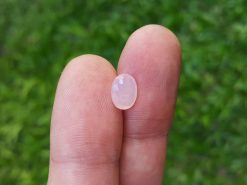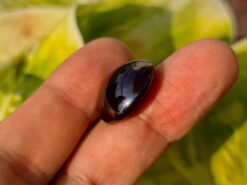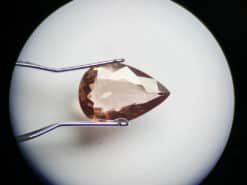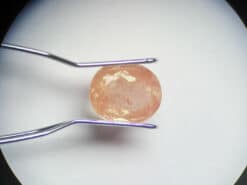Mica

The mica group of sheet silicate, phyllosilicate minerals includes several closely related materials having nearly perfect basal cleavage.
Buy natural gemstones in our gem shop
Mica is pseudohexagonal crystal
All are monoclinic, with a tendency towards pseudohexagonal crystals, and are similar in chemical composition. The nearly perfect cleavage, which is the most prominent characteristic, is explained by the hexagonal sheet-like arrangement of its atoms.
The name is derived from the Latin word mica, meaning a crumb, and probably influenced by micare, to glitter.
Mica sheets occurrence
It is widely distributed and occurs in igneous, metamorphic and sedimentary regimes. Large crystals used for various applications are typically mined from granitic pegmatites.
Until the 19th century, large crystals were quite rare and expensive as a result of the limited supply in Europe. However, their price dramatically dropped when large reserves were found and mined in Africa and South America during the early 19th century.
The largest documented single crystal phlogopite was found in Lacey Mine, Ontario, Canada, it measured 10 m × 4.3 m × 4.3 m (33 ft × 14 ft × 14 ft) and weighed about 330 tonnes (320 long tons, 360 short tons). Similar-sized crystals were also found in Karelia, Russia.
Muscovite mica
The British Geological Survey reported that as of 2005, Koderma district in Jharkhand state in India had the largest deposits in the world. China was the top producer with almost a third of the global share, closely followed by the US, South Korea and Canada.
Large deposits of sheet were mined in New England from the 19th century to the 1970s. Large mines existed in Connecticut, New Hampshire, and Maine.
Production of mica rocks
Scrap and flake mica is produced all over the world. In 2010, the major producers were Russia (100,000 tonnes), Finland (68,000 t), United States (53,000 t), South Korea (50,000 t), France (20,000 t) and Canada (15,000 t). The total global production was 350,000 t, although no reliable data were available for China.
Most sheet was produced in India (3,500 t) and Russia (1,500 t). Flake comes from several sources: the metamorphic rock called schist as a byproduct of processing feldspar and kaolin resources, from placer deposits, and from pegmatites.
The most important sources of sheet are pegmatite deposits. Sheet prices vary with grade and can range from less than $1 per kilogram for low-quality to more than $2,000 per kilogram for the highest quality.
Mica meaning and healing metaphysical properties benefits
The following section is pseudo scientific and based on cultural beliefs.
Mica diminishes nervous energy, calms an overthinking mind while positively enhancing intellectual pursuits and mental situations. It may be used to help treat insomnia and diminish the sleeping requirements of mononucleosis. And also be used to help relieve conditions of dehydration.
Some say the stone is also connected to the heart chakra, while others believe that the pigment of the stone affects which chakra is associated with.
Mica from Mogok, Myanmar
FAQ
What is mica used for?
The stone is a naturally occurring mineral dust often used in makeup foundations, as filler in cement and asphalt, and as insulation material in electric cables. It is found un : Makeup products, shingles, wallpaper, insulation, cement and asphalt.
What does mica do spiritually?
The rock is a variety of Muscovite with a beautiful reflective pearly luster occurring in the forms of flakes, sheets, and layers. It facilitates clarity in vision and mysticism. The stone diminishes nervous energy, calms an overthinking mind while positively enhancing intellectual pursuits and mental situations
Is mica harmful to the skin?
As one of the most important mineral ingredients in cosmetics, it used widely to add shimmer and sparkle. Because it is naturally produced it is a particularly well-loved ingredient among organic and natural beauty brands, and is safe to use on almost all skin types with little to no side effects.
















